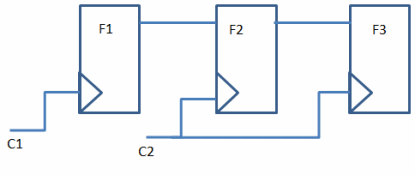Handling Asynchronous Clock Groups in SDC
Sanjay Churiwala & Balachander Krishnamurthy, Xilinx
EETimes (11/15/2013 04:40 PM EST)
Introducing CDC
Most SoC designs in today's world employ multiple clocks and commonly have many clock domains. As data crosses from one clock domain to another within the design, the potential for metastability problems arises due to asynchronous clock domain crossings (CDCs).

Figure 1: An asynchronous crossing with simple double flop synchronization.
In Figure 1, there is an asynchronous CDC for the data going from flop F1 (clocked by C1) into F2 (clocked by C2), assuming that C1 and C2 are asynchronous with respect to each other.
To read the full article, click here
Related Semiconductor IP
- ARC4 Core for Xilinx FPG
- Xilinx Virtual Cable
- Xilinx HMC Controller
- Xilinx MicroBlaze Trace Core (XMTC)
- Xilinx Kintex 7 NVME HOST IP
Related White Papers
- Asynchronous Logic: large CMOS devices without a clock tree
- Verifying Dynamic Clock switching in Power-Critical SoCs
- Ultra Low Power Designs Using Asynchronous Design Techniques (Welcome to the World Without Clocks)
- High-Performance DSPs -> DSP performance: Useful work per clock tick
Latest White Papers
- Ramping Up Open-Source RISC-V Cores: Assessing the Energy Efficiency of Superscalar, Out-of-Order Execution
- Transition Fixes in 3nm Multi-Voltage SoC Design
- CXL Topology-Aware and Expander-Driven Prefetching: Unlocking SSD Performance
- Breaking the Memory Bandwidth Boundary. GDDR7 IP Design Challenges & Solutions
- Automating NoC Design to Tackle Rising SoC Complexity